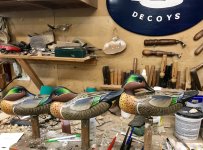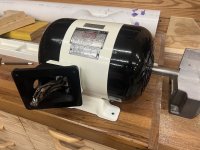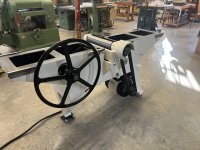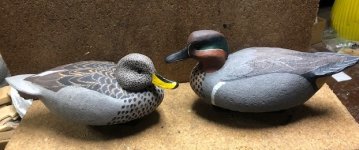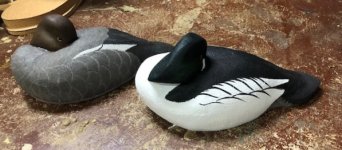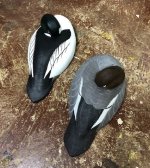You are using an out of date browser. It may not display this or other websites correctly.
You should upgrade or use an alternative browser.
You should upgrade or use an alternative browser.
Workbench - November
- Thread starter MLBob Furia
- Start date
Trying to improve with each decoy. Here is my take on the wireless canvas Canada Goose:
The canvas is stretched over the boards and secured with staples from a pneumatic stapler. The canvas is then painted with a mod podge decoupage glue/sealer to stiffen it a bit and provide some water resistance. The interior wood and bottom board are all atlantic cedar. The head/neck is some type of cedar -- maybe red? (I don't know for certain) It's very lightweight. takes paint well, and doesn't rot. The canvas is scrap from a paint drop cloth, although for my next decoy I am going to purchase some heavier material I found at a hobby/cloth store.

The bottom of the canvas is secured over the staples with a 3/4 inch cotton binding, applied with roofing nails. The bill and neck seam areas are painted with an expoy-paint mix. This is intended to strengthen the bill, and add waterproofing to the neck seam. I finally obtained a packet of 12mm acrylic eyes and applied them. You can see the vague outline of my painting plan on the canvas.
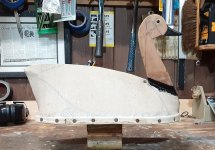
The canvas is primed with Zinser 123 primer.
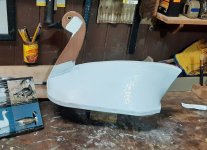
I've applied the first coat of acrylic paint for a base layer. The paint scheme is loosely based on a Nick Sapone Canada Goose I currently have in my den. Nick Sapone is a well known maker of canvas & wire decoys here in North Carolina. He lives in Wanchese, NC on Roanoke Island.

My finished decoy. I applied an overcoat of decoupage to cut the glare and provide more of a matte finish. I sealed the bottom board with Thompson's water seal and added a 1-inch nylon loop for attaching the anchor.

This decoy measures 18 inches in length and is just over 12 inches tall. Based on my prior experiences with these kinds of decoys, I believe it will float well and move with the slightest breeze.

The canvas is stretched over the boards and secured with staples from a pneumatic stapler. The canvas is then painted with a mod podge decoupage glue/sealer to stiffen it a bit and provide some water resistance. The interior wood and bottom board are all atlantic cedar. The head/neck is some type of cedar -- maybe red? (I don't know for certain) It's very lightweight. takes paint well, and doesn't rot. The canvas is scrap from a paint drop cloth, although for my next decoy I am going to purchase some heavier material I found at a hobby/cloth store.

The bottom of the canvas is secured over the staples with a 3/4 inch cotton binding, applied with roofing nails. The bill and neck seam areas are painted with an expoy-paint mix. This is intended to strengthen the bill, and add waterproofing to the neck seam. I finally obtained a packet of 12mm acrylic eyes and applied them. You can see the vague outline of my painting plan on the canvas.

The canvas is primed with Zinser 123 primer.

I've applied the first coat of acrylic paint for a base layer. The paint scheme is loosely based on a Nick Sapone Canada Goose I currently have in my den. Nick Sapone is a well known maker of canvas & wire decoys here in North Carolina. He lives in Wanchese, NC on Roanoke Island.

My finished decoy. I applied an overcoat of decoupage to cut the glare and provide more of a matte finish. I sealed the bottom board with Thompson's water seal and added a 1-inch nylon loop for attaching the anchor.

This decoy measures 18 inches in length and is just over 12 inches tall. Based on my prior experiences with these kinds of decoys, I believe it will float well and move with the slightest breeze.

Last edited:
jode hillman
Well-known member
Jode Hillman! My god those Teal look amazing!! What paints do you use to get that iridescence? I am starting a canvas teal.
I do use a moderate amount of care with the canvas birds I hunt. One thing that has evolved with me is the reduction in the numbers of decoys I carry....from 3 dozen down to 1 dozen. maybe that's part of the evolution of a duck hunter.
Good luck!
I do use a moderate amount of care with the canvas birds I hunt. One thing that has evolved with me is the reduction in the numbers of decoys I carry....from 3 dozen down to 1 dozen. maybe that's part of the evolution of a duck hunter.
Good luck!
Last edited:
jode hillman
Well-known member
Joe Friday said:Jode Hillman! My god those Teal look amazing!! What paints do you use to get that iridescence? I am starting a canvas teal.
I do use a moderate amount of care with the canvas birds I hunt. One thing that has evolved with me is the reduction in the numbers of decoys I carry....from 3 dozen down to 1 dozen. maybe that's part of the evolution of a duck hunter.
Good luck!
That's great Joe. I find Decoys mostly get beat up in the back of the truck, or in the boat, or by having the dog step on them. I tend to treat my Decoys with a little bit more care as well.
Thanks Joe for the kind words on the teal.
The painting on those is with artist oil paint. On the eye patch I am using a transition from black to dark green to yellow white and then back again. There is no iridescence per se it is just insinuated.
Last edited:
Well, I actually have a few things going on. I bought a Shopsmith model 510 from my uncle and my dad is teaching me how to use it. We started 'lessons' last night. He has a model 500 that he has had for longer than I have been alive and loves the Shopsmith for lots of things. It is not the best table saw but for someone like me who doesn't have need all that frequently of a dedicated table saw, my shopsmith will likely work. Especially since I have table extensions that he does not have.
He is also helping me to build a coffee table that will have storage in it. This is it mostly dry fitted. I am sure he will incorporate some of the lessons into finishing it up.


I have not totally decided yet if I want the lid to lift on hinges or if I want it to just lift off.
He is also helping me to build a coffee table that will have storage in it. This is it mostly dry fitted. I am sure he will incorporate some of the lessons into finishing it up.


I have not totally decided yet if I want the lid to lift on hinges or if I want it to just lift off.
patrick mccarthy
Well-known member
MLBob Furia
Well-known member
jode hillman said:Nice work Bob. It's been a while since you've turned any calls hasn't it?
[size 4] Thanks, Jode.
Callmaking is pretty much limited to when I get requests rather than making batches to sell. But I always have the raw materials on hand.
Did some duck calls for a fundraiser sporting clays shoot last month. In exchange , they invited me to come shoot for free, fed me, + provided my shells. These days that's a good trade-off considering the cost of ammo [
Looks like your new pup is going to be a dandy!
Dani
Very nice. I think you will find the Shopsmith can take on a lot of tasks. You can get obsessed with rounding up all the accessories too.
Eric
Very nice. I think you will find the Shopsmith can take on a lot of tasks. You can get obsessed with rounding up all the accessories too.
Eric
Steve Sanford
Well-known member
Good morning, All~
Fine work all around!
I've got a bunch of projects in process.
From last weekend's SSWA Duckboat Show, I brought back lots of fine memories - and some memorabilia as well.
This is the South Bay Duckboat I delivered to its owner at the Show (another South Bay is in the shop right now....). This is not the owner, but it was being appreciated by an old friend and his 2 boys. I got the "old friend" his first ducks 30+ years ago. The gun rest is a new feature.
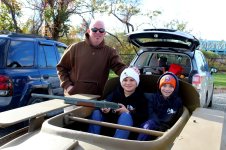
Amongst the loot I brought back North was this old Herter's Model Canada Mallard Drake - a gift from another friend.
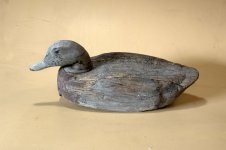
He's worked hard all his life - apparently for a certain "JHZ".
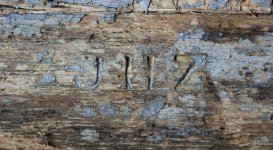
As I have posted previously, I have been putting together a rig of these oversize birds from the late-40s, early-50s. This latest contribution fills my 8-slot bag.
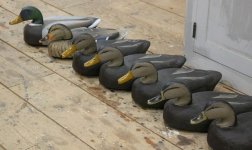
Another balsa-bodied bird came from yet another friend. It's a Superior Model from the Quogue factory. He knew I'd like the high-head posture. The head is especially well-shaped.
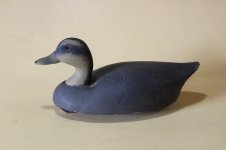
It needed a bit of repair - and the neck-to-breast transition was a bit "lumpy" to my eye.
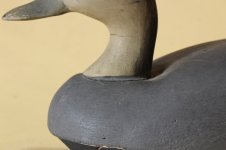
So, some sanding, filling and fairing was called for.....
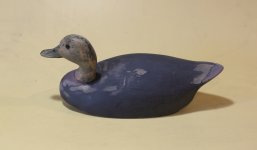
Here's the new line - much sweeter to my eye.
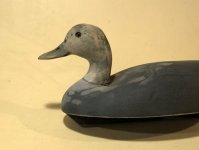
I have not yet decided whether it'll stay a Black - probably a Drake - or become a Hen Mallard. I need to survey the whole rig, which is now over a dozen birds. In any event, it got a careful sealing coat of Spar Varnish. The Drake feels a bit heavy - maybe still water-logged - so he'll dry near the wood stove for a month or so. Both birds need to wait for my further attention until I can complete the duckboats and decoys currently in my queue.....
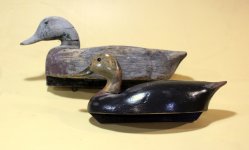
Stay tuned!
SJS
Fine work all around!
I've got a bunch of projects in process.
From last weekend's SSWA Duckboat Show, I brought back lots of fine memories - and some memorabilia as well.
This is the South Bay Duckboat I delivered to its owner at the Show (another South Bay is in the shop right now....). This is not the owner, but it was being appreciated by an old friend and his 2 boys. I got the "old friend" his first ducks 30+ years ago. The gun rest is a new feature.

Amongst the loot I brought back North was this old Herter's Model Canada Mallard Drake - a gift from another friend.

He's worked hard all his life - apparently for a certain "JHZ".

As I have posted previously, I have been putting together a rig of these oversize birds from the late-40s, early-50s. This latest contribution fills my 8-slot bag.

Another balsa-bodied bird came from yet another friend. It's a Superior Model from the Quogue factory. He knew I'd like the high-head posture. The head is especially well-shaped.

It needed a bit of repair - and the neck-to-breast transition was a bit "lumpy" to my eye.

So, some sanding, filling and fairing was called for.....

Here's the new line - much sweeter to my eye.

I have not yet decided whether it'll stay a Black - probably a Drake - or become a Hen Mallard. I need to survey the whole rig, which is now over a dozen birds. In any event, it got a careful sealing coat of Spar Varnish. The Drake feels a bit heavy - maybe still water-logged - so he'll dry near the wood stove for a month or so. Both birds need to wait for my further attention until I can complete the duckboats and decoys currently in my queue.....

Stay tuned!
SJS
Steve Sanford
Well-known member
Good morning, Eric~
Gorgeous! - best of luck with her!
If you spotted the Adirondack chair in one of my "floorboard" photos - it needed one new Cedar slat.
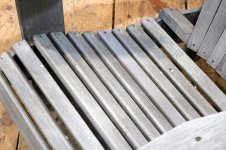
It came in the shop as part of the Fall Cleanup. All the leaves are handled - and I may sneak a coat of paint (Cabot Stain actually) on this furniture amidst the duckboats and decoys.

This little mushroom needs just a just of paint in 2 chips. I brought it home just because it's such an elegant design. I will likely not fill the chips, just arrest the rust with TrailerCoat next time I have the can open.
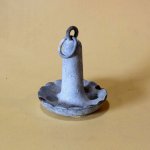
The overall shape, the fluted edges and the star motif show an artist's eye....

BTW: Anyone know this foundry? I found a similar anchor from a T P maker - but not yet this one - which I believe s P Co.

And, this paddle - the all-varnish beavertail right-of-center - will become my son's Christmas gift - after a thorough refinishing.

Back to the shop...floorboards, thatch rails, mounting blocks.....
SJS
Gorgeous! - best of luck with her!
If you spotted the Adirondack chair in one of my "floorboard" photos - it needed one new Cedar slat.

It came in the shop as part of the Fall Cleanup. All the leaves are handled - and I may sneak a coat of paint (Cabot Stain actually) on this furniture amidst the duckboats and decoys.

This little mushroom needs just a just of paint in 2 chips. I brought it home just because it's such an elegant design. I will likely not fill the chips, just arrest the rust with TrailerCoat next time I have the can open.

The overall shape, the fluted edges and the star motif show an artist's eye....

BTW: Anyone know this foundry? I found a similar anchor from a T P maker - but not yet this one - which I believe s P Co.

And, this paddle - the all-varnish beavertail right-of-center - will become my son's Christmas gift - after a thorough refinishing.

Back to the shop...floorboards, thatch rails, mounting blocks.....
SJS
Steve
Whether big or small, the projects you take on in your shop are always interesting pleasing to the eye.
Eric
Whether big or small, the projects you take on in your shop are always interesting pleasing to the eye.
Eric
Richard Lathrop
Well-known member
Eric,
I agree your and Steve's shops are too clean and organized. I may steal Steve's oar rack idea.
Rick Lathrop
I agree your and Steve's shops are too clean and organized. I may steal Steve's oar rack idea.
Rick Lathrop
Steve Sanford
Well-known member
Good morning, Richard~
I took some photos and measurements of my "Paddle & Pole Rack" for you - and will post them separately.
All the best,
SJS
I took some photos and measurements of my "Paddle & Pole Rack" for you - and will post them separately.
All the best,
SJS
Steve Sanford
Well-known member
Matt DeFore
Active member

Last edited:
Vince Pagliaroli
Well-known member
Decoy Monster Machine,
That's a mighty fine pair of King Divers. Two thumbs way up.
After a long migratory flight that's the first thing I've seen them do. A snooze, then search for food = whistling wings aloft.
Best regards
Vince
Steve Sanford
Well-known member
Matt~
Sweet Ringbill! I love the paint in the tertials/speculum.
Cork?
All the best,
SJS
Sweet Ringbill! I love the paint in the tertials/speculum.
Cork?
All the best,
SJS
Vince Pagliaroli
Well-known member
Matt,
Your cork Ringbill is a good one. The essence of the duck is there, no matter the paint.
Eyes say - "You talkin to me...?" That's style. Texture on the head a plus.
Mighty fine duck the Ringbill in all aspects, yet seldom gets the respect it deserves. Damn shame.
Best regards
Vince


